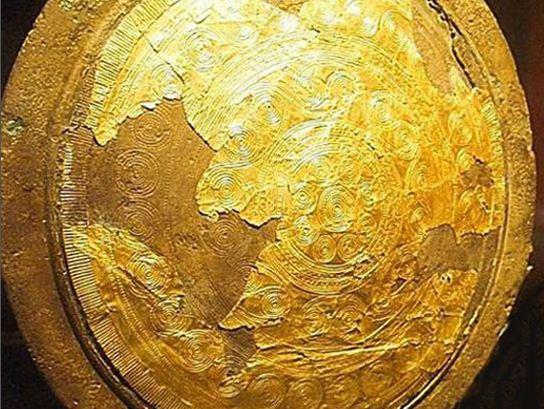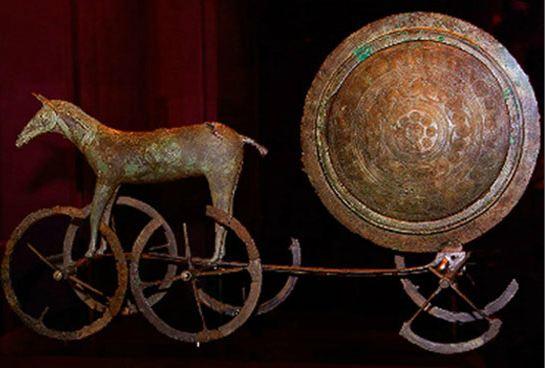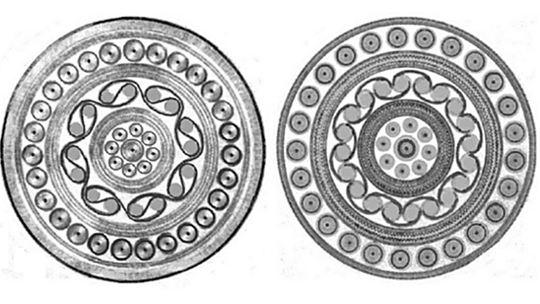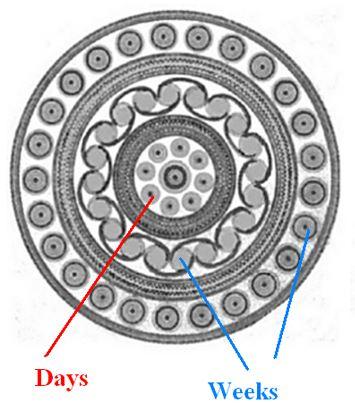Rossella Lorenzi
Source - http://news.discovery.com/history/bronze-age-calendar-120330.html
A Bronze Age calendar could be hidden in this 3,400-year-old bronze statue, according to a new study into the artifact's finely carved decorations.

Gianni Dagli Orti/Corbis
Known as the Trundholm sun chariot, the sculpture shows a disk mounted on four wheels and pulled by a horse.
Also known as Solvognen, the sun chariot is now in the collection of the National Museum of Denmark in Copenhagen.
The sculpture was discovered in 1902 in a bog at Trundholm on the Danish island of Seeland. Experts believe that it was buried there as a ritual offering around 1400 BC.

Kim Bach
Approximately 10.23 inches across, the sun disk is made of two bronze plates decorated with concentric circles and spirals. The plates are soldered together using an outer ring: one side is gold plated, representing the sun during the day.
"The decorations in both sides of the disk include circular grooves, spirals and circles ordered in various rings. They could simply be some beautiful ornamentation. But they could well contain a mathematical puzzle," Amelia Carolina Sparavigna, assistant professor at the department of physics of Turin's Polytechnic University, told Discovery News.
She detailed her research in a paper published on the arXiv physics website.

Malene Thyssen/Wikimedia Commons
The two sides of the sun disk have been interpreted as a depiction of the sun as it is drawn across the heavens from East to West during the day, presenting its bright side to the Earth and then returns from West to East during the night, when the dark side faces Earth.
Representing the daily journey of the sun and the progression of the year and the recurrence of the seasons, the bronze sculpture might contain a 360-day calendar.

Kim Bach/Wikimedia Commons
The theory that the disk might have a "calendar knowledge" was first proposed by Klavs Randsborg, professor of archaeology at the University of Copenhagen.
He suggested that decorations in certain Danish Bronze Age artifacts were based on the knowledge of years, months and days.

Amelia Carolina Sparavigna
For example, for the night side of the disk, Randsborg pointed out that the sum of spirals in each circle of the disk, multiplied by the number of the circles in which they are found, counted from the middle (1x1 + 2x8 + 3x20 + 4x25), results in a total of 177. That figure comes very close to the number of days in six synodic months.
The synodic cycle is the time that elapses before a specific object will reappear at the same point in the sky when observed from the Earth, so it is the apparent orbital period observed from Earth.
The math formula could then represent a Moon calendar (and a Sun-calendar for the diurnal side of the disk).

Amelia Carolina Sparavigna
Sparavigna proposed a different, possibly easier, interpretation for the night disk. In her theory, the eight concentric circles of the first ring would represent the days of a week.
Containing a total of 45 circles, 20 in one ring and 25 in the other, the outer two rings would represent the weeks of the year.
"If we consider the winter solstice as the beginning of the year, the two groups could represent two seasons: one a 'young sun' made of 20 weeks, followed by the season of a 'mature and then old sun' made of 25 weeks," Sparavigna said.
By multiplying the eight days of the week by 45 weeks, Sparavigna obtained a 360-day calendar.

Amelia Carolina Sparavigna
The Trundholm disk would then become a nundinal calendar.
On the left: the calendar shows a red marker for a day of the week (the first) and a blue marker for a week (the second in the "first season"). The calendar would thus read: the first day of the second week of the first season.
On the right: the calendar shows a red marker for a day of the week (the third) and a blue marker for a week (the fifth in the "second season"). The calendar would thus read: the third day of the fifth week of the second season.
As for the gilded day-side of the disk, Sparavigna believes that the total number of spirals, central included, (52) may hint at another mathematical puzzle, possibly resulting in the Trundholm disk being a two-cycle calendar.
"If we assume that each spiral is representing a week having seven days, we can obtain a 364-day calendar. The larger central "week" could contain one or two extra days, depending on years," she said.